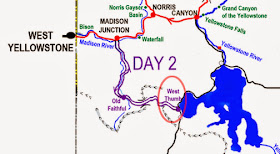DAY 2:
Travel from the Upper Basin (the home of Old Faithful) to Yellowstone Lake (cross the Continental Divide - not only once but twice: that is the funny black line on the map).
At the elevation of some 2300 m above the sea level, the lake Yellowstone is the highest large body of water in North America. Large it is - one would have to walk 225 km to make a complete loop around it. It is deep and it is a part of the large Yellowstone Caldera.
 |
| Photo of the display of West Thumb Basin |
 |
| This map of West Thumb walkway and hydrothermal features is from Wikipedia |
There is so much to be learned in an area of only one km square!
I finally have to admit that during my entire Yellowstone trip (as for the most of the past year), my back had been hopelessly OUT. The beauty and interesting natural phenomena still made me hobble through the trip but I paid much less attention to things that deserved it. Our walk between the info-sign and Abyss Pool of West Thumb is just a blur in memory - try as I want, it is now difficult to attach names to the springs photographed below.
At the end - it was an amazing walk - lumbago or not.
(For all those sufferers out there - who put me finally back on my feet was a a physiotherapist using
hurley-osborn technique.)
As for the hot spring names: let others figure out the ones that I neglected. Hopefully there will be one more time.
Some of the hot springs in the middle part of West Thumb.
Abyss Pool is a hot spring - it got its name because of its depth - it also offers a view of Yellowstone Lake.

 Black Pool is not black in this photo - the name originated some time ago when the pool temperature was lower and more suitable to algae - the growth was such that the pool seemed to be much darker. Then for some reason the temperature rose and the algae died - the pool is now blue-green (thanks to the refracting light). Mineral salts and microorganisms at the edges create amazing abstract designs.
Black Pool is not black in this photo - the name originated some time ago when the pool temperature was lower and more suitable to algae - the growth was such that the pool seemed to be much darker. Then for some reason the temperature rose and the algae died - the pool is now blue-green (thanks to the refracting light). Mineral salts and microorganisms at the edges create amazing abstract designs. Geysers at the bottom of the lake - their cones spewing hot water into their cold surroundings. Their cones are just above the surface but when the water in the the lake is high they can be submerged. This is Big Cone. Water coming up is boiling hot. The geysers could shoot up - they have in the past but when we visited they were quite dormant.
Geysers at the bottom of the lake - their cones spewing hot water into their cold surroundings. Their cones are just above the surface but when the water in the the lake is high they can be submerged. This is Big Cone. Water coming up is boiling hot. The geysers could shoot up - they have in the past but when we visited they were quite dormant.
The cone below is named Fishing Cone; previously Chowder Cone - that's because people say that it was possible to catch a fish in the lake and, poor fish still on the line, dip it into this cone and have it cooked. I think that every fish in the lake would enjoy an idea of a fisherman slipping off and into the cone as well. This unfortunately happened in 1921.
In any case - it is forbidden to step anywhere past the wooden walkways so nowadays the fish in West Thumb area can swim in peace. Fishing Cone geyser erupted several times in the past hundred years.
A rusty runoff from one of the hot springs in central area makes for another abstract creation of this wonderful area.
Mud Pots can be found in acidic areas where sulphuric acid and microorganisms supported by small amounts of water, dissolve the rocks.
Mud Pots are usually whitish or gray. Some are coloured by minerals or microorganisms - in that case they are called Paint Pots
Depending on the amount of available water, the Mud Pots can be like clay or like a pool of muddy water.
This was an amazing visit, we agreed that this was one of the best stops we had so far.















No comments:
Post a Comment